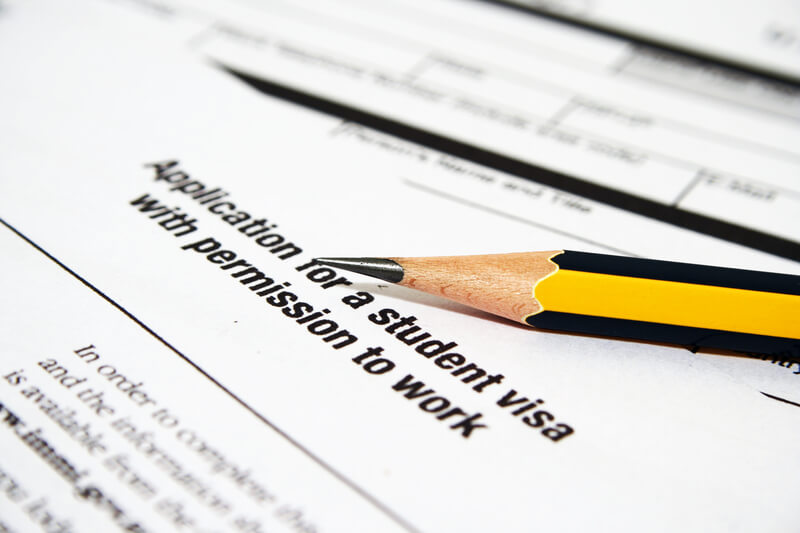A student visa allows you to enter the United States as a full-time student at an accredited educational institution. This ranges from 4 year universities and seminaries, to elementary schools and language training programs. Anyone in the U.S. on a student visa must be enrolled in an academic program that will present them with a degree, diploma, or certificate. They cannot necessarily work without a work visa, apart from the student visa. Any school must also be eligible by the U.S. government to take international students.
Applying For a Student Visa
If you’ve been accepted to a U.S. school to study, congratulations are in order. But that acceptance is just the beginning. Depending upon the country, student visas may be hard to come by. If they are available, you’ll need to be fully prepared for the documents necessary, and the red tape you may have to wade through. When applying for a visa you’ll have to present your current valid passport, as well as a photo that will be used for your student visa, and your official test scores and transcripts.
You’ll need to provide proof of finances, such as bank statements or pay stubs, and printed copies of both your DS-160 and I-901 SEVIS payment confirmation.Finally, you’ll need to have your completed I-20 Form. The I-20 should be kept throughout the entire life of the student visa. It is one of the most important documents that a foreign student studying in America can possess. Your I-20 Form lists the start date of your program, but you are permitted to enter the country up to 30 days before that date.
A consulate requires you to have the original I-20 form when you apply. In some cases a copy is acceptable. However, upon entering the U.S., you are expected to have your original I-20 Form ready to present. Do not keep it folded up or in a bag, as ICE will ask you to present this document immediately.
Types of Student Visas
There are 3 different categories and 3 different types of visas for which a student can apply. However, before the application process can even begin, you must be officially accepted to an educational institution in the U.S.
F Visa
More commonly referred to as a F-1 Visa, this visa allows a foreign national to live in the U.S. for a set period of time as a student. Only as long as he or she is enrolled in an educational institution. This visa comes with an implied understanding that you are staying in the United States temporarily. This is in no way a precursor to an immigrant visa.
Most F-1 students are allowed to travel while on their visas, as long as the trip is less than 30 days. You will be permitted reentry to the United States on a valid F-1 visa. Sometimes, even a recently expired F-1 visa. As long as you have not applied for a new visa during your travel.
M Visa
An M-1 visa also allows student entry into the United States, however this visa applies to nonacademic studies, or what is more commonly referred to as vocational studies. M-1 student visas do not allow a student to simply study generally, or take a variety of classes. There must be a program with a full course of study, at a community or junior college. Here, 12 hours a semester is considered a full semester. M-1 students must also be ready to show proof that all living costs and expenses can be covered during the student’s stay.
J Visa
J-1 visas are non-immigrant visas wherein the recipient is coming to the United States as part of a study or work based exchange program. However, in certain cases this can also apply to cultural exchange programs as well. For example, nurses, doctors, au pairs, teachers, professors, and even scholars. These individuals frequently avail themselves of such visas. Mainly, in order to train in new techniques or gain access to new information. Such information may not be available to them in their home country.
Those participating in an exchange program on a J-1 Visa are also permitted to travel during their exchange. However, if they travel outside the country for more than 30 days, they are considered to have abandoned their program.
Expiration
If you are in the United States on an expired student visa, it is strongly recommended that you apply for a new visa. Remaining in the country without the proper authorization can lead to negative consequences. Possibly even deportation. In addition, if you travel with an expired student visa, and attempt to return to the United States, you will not be granted entry. This can cause a variety of problems, such as the inability to complete your desired course of study .
There are grace periods surrounding expired student visas, but they vary spending on the type. An expired J1 student visa holder has 30 days to stay in the United States. Then an expired F-1 visa holder has 60 days. Finally, an expired M1 visa holder can remain in the country so long as they maintain their student status.
Take Steps Towards Understanding Student Visas
Student visas allow foreign residents to gain cultural and practical knowledge they might otherwise have no access to. However, the process can be involved, and may contain pitfalls with which any visa holder may need help.
If you find yourself in a situation where you require assistance with your existing visa, or in reapplying because your visa has expired, you may wish to reach out to a local attorney for the counsel and expertise to navigate the visa and immigration laws in the U.S. Submit a request online or call us today at (866) 345-6784 to get in touch with an attorney in your area!

